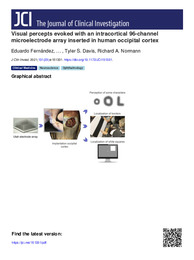Por favor, use este identificador para citar o enlazar este ítem:
https://hdl.handle.net/11000/26671
Visual percepts evoked with an intracortical 96-channel microelectrode array inserted in human occipital cortex
Título :
Visual percepts evoked with an intracortical 96-channel microelectrode array inserted in human occipital cortex |
Autor :
Fernández Jover, Eduardo |
Departamento:
Departamentos de la UMH::Medicina Clínica |
Fecha de publicación:
2021-12 |
URI :
http://hdl.handle.net/11000/26671 |
Resumen :
BACKGROUND. A long-held goal of vision therapy is to transfer information directly to the visual cortex of blind individuals, thereby restoring a rudimentary form of sight. However, no clinically available cortical visual prosthesis yet exists.
METHODS. We implanted an intracortical microelectrode array consisting of 96 electrodes in the visual cortex of a 57-year-old person with complete blindness for a 6-month period. We measured thresholds and the characteristics of the visual percepts elicited by intracortical microstimulation.
RESULTS. Implantation and subsequent explantation of intracortical microelectrodes were carried out without complications. The mean stimulation threshold for single electrodes was 66.8 ± 36.5 μA. We consistently obtained high-quality recordings from visually deprived neurons and the stimulation parameters remained stable over time. Simultaneous stimulation via multiple electrodes was associated with a significant reduction in thresholds (P < 0.001, ANOVA) and evoked discriminable phosphene percepts, allowing the blind participant to identify some letters and recognize object boundaries.
CONCLUSIONS. Our results demonstrate the safety and efficacy of chronic intracortical microstimulation via a large number of electrodes in human visual cortex, showing its high potential for restoring functional vision in the blind.
|
Área de conocimiento :
CDU: Ciencias aplicadas: Medicina |
Tipo de documento :
info:eu-repo/semantics/article |
Derechos de acceso:
info:eu-repo/semantics/openAccess |
DOI :
http://doi.org/10.1172/JCI151331 |
Aparece en las colecciones:
Instituto de Bioingeniería
|
 La licencia se describe como: Atribución-NonComercial-NoDerivada 4.0 Internacional.
La licencia se describe como: Atribución-NonComercial-NoDerivada 4.0 Internacional.

 La licencia se describe como: Atribución-NonComercial-NoDerivada 4.0 Internacional.
La licencia se describe como: Atribución-NonComercial-NoDerivada 4.0 Internacional.
.png)